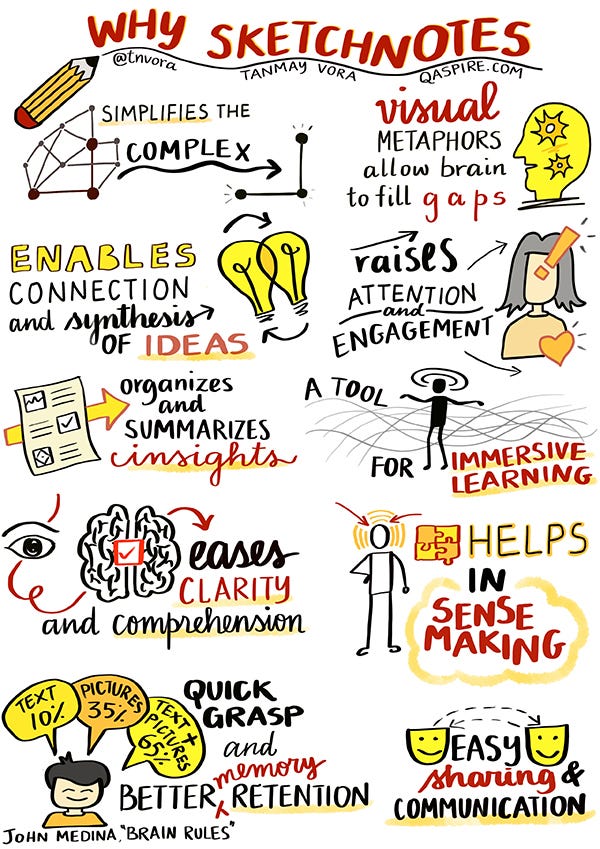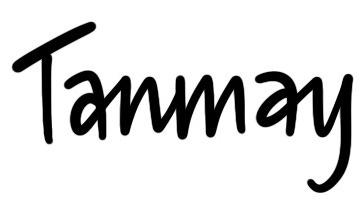How I Discovered Visual Thinking
A few experiences that led me to visual thinking
In case you are new here:
Visit my work and blog at QAspire.com (blogging since 2006)
If you are keen to learn visual thinking and sketchnotes as a tool to learn, communicate with clarity and see/solve problems, check out and register for the immersive workshop happening on 24th Jan 2025.
Check out Visual Leadership Pack of HD Sketchnotes – a compilation of high-resolution sketchnotes covering 90+ powerful (and timeless) ideas to elevate your leadership and learning game. Ideal for coaches, leaders and learners.
Support my work by considering a paid subscription.
An Early Career Crisis
I was laid off in 2001 after the company I worked for went bust after 9/11 attacks in the US. Till that point, I was a few years into software development, working hard to get ahead.
After a clueless first month with very few job openings in software engineering, I picked up a piece of blank paper and a pen in desperation. Staring at that blank canvas, I started writing an inventory of my skills in a non-linear fashion, randomly on the page. I encircled some of the key skills that were clearly my strengths like software engineering, writing, communication, database management and so on.
As I kept staring at those circles, two circles magically formed a virtual intersection in my mind. Technology and writing. Interestingly, I had learned technology but writing was an inherent skill that others told me I was good at.
I reframed my job search to technical writing and in two weeks, landed a job that became my gateway into the corporate life. All thanks to a virtual venn diagram revealing an intersection between two encircled skills that my mind could see.
A simple act of drawing circles around ideas instead of creating a list enabled me to “see” a possibility that I wouldn’t have seen otherwise.
This was my first experience of visual thinking.
The Inattentive Customer
Cut to January of 2009. I was on a business trip to Finland where I had a scheduled early morning meeting with a prospect (and his team) who was VP of Quality for a large corporation. At 7:00 AM, I stepped into a large conference room with glass walls overseeing a frozen lake. I opened my carefully curated powerpoint presentation outlining the proposed solution to their process challenges.
As soon as I started the presentation, the prospect slid down the chair, closed his eyes and stopped responding. He was a key decision maker who wouldn’t pay attention. After a few minutes of feeling like speaking to the glass walls, I knew I had to do something radical to gain his attention.
In that moment of frustration, I closed the lid of my laptop, turned off the projector and exposed the whiteboard screen. I grabbed a few colored markers and started drawing their “as-is” process flow highlighting gaps with red circles.
As soon as I did this, the client slowly opened his eyes, got up and joined me on the whiteboard with some markers. As I plotted their “as-is” and proposed “to-be” processes, he would correct my understanding, suggest ideas and help me create a solution that they were looking for.
My act of ditching powerpoint and initiating the drawing on the whiteboard changed energy in the room. It nudged client to join me on the whiteboard to “co-create” a solution. It was a “human” way to engage with ideas and with others through hand-drawn shapes and arrows.
This tactile way of drawing the process also demonstrated my understanding of their challenges. We not only bagged the project but built a large team for the client spread over a few years.
This revealed the power of visual thinking to me, without knowing the science behind it. In 2014, I stumbled upon the awesome work of
and .And I found yet another intersection to explore - visual thinking combined with my lived experience of leadership, learning and change. Illuminating timeless ideas on leadership, learning and change through sketchnotes became my pursuit since 2015.
Since then, I have been using visual tools for ideation, making problems visible, collaborating with groups to solve them, facilitate strategy sessions, reengineer processes, coach people and communicate with clarity.
I believe we are all born as visual thinkers. We first draw random shapes before we are programmed to write in school.
Our education system programs us out of our visual thinking super powers and orients us to text heavy ways of learning.
Here’s why sketchnotes are my chosen medium to curate timeless ideas:
Want to Reclaim Your Visual Thinking Super Powers?
Join 4000+ others who attended our monthly visual thinking workshop where we learn how to think visually through immersive draw along exercises.
The first edition of 2025 is happening on 24th January 2025. Do check it out and register.
From My Journal
This time, seven key attitudes of mindfulness from Jon Kabat Zinn.
That’s it for this edition. Thank you for subscribing and reading.





Tanmay, I had not realized how "at the moment" your introduction to visual thinking your experience was with the client zoning out on your well-crafted PowerPoint! What a great story!
I have felt the same when working on a whiteboard or a piece of paper with one or more people: something naturally happens that engages everyone, and using the space to capture ideas visually becomes fun.
Thanks for all your work to move the visual thinking community forward!
Tanmay it is a treat to see your visual thinking skills. And yes Mike Rohde got me going on the journey as well. I loved his books. Keep inspiring.